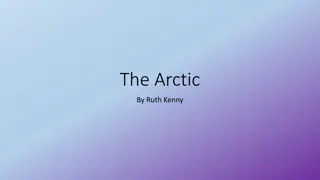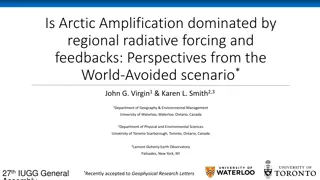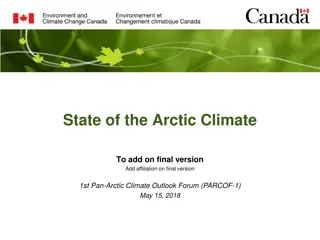Exploring Arctic Adventures: Frozen Dreams Discussion
Dive into the dangerous and courageous world of Arctic exploration with Lauren Tarshis' "Frozen Dreams DiscussionFebruary.Scope". Discover the challenges faced by Matthew Henson, the differences and similarities between Henson and Peary, and the significance of Henson's friendships with the Inuit in
0 views • 21 slides
The Arctic in the Anthropocene: Emerging Research Questions
The study sponsored by organizations like DOE, NASA, NOAA, NSF, Smithsonian, and USARC delves into the significant implications of Arctic changes on ecosystems, climate, and humanity. The report emphasizes the urgent need for continued research in the Arctic to understand and address the rapid clima
1 views • 23 slides
Discovering the Arctic: A Wintery Wonderland
The Arctic, located in the northernmost part of our planet, is a captivating region comprising the Arctic Ocean and territories of various countries. Home to unique wildlife like polar bears, snowy owls, and Narwhals, the Arctic also houses indigenous communities such as the Inuits. Learn about iglo
2 views • 7 slides
Understanding the Impact of Arctic Warming Through Air-Sea Coupling
Investigate the role of air-sea coupling in amplifying or dampening the impact of Arctic warming on northern continents using coordinated coupled model experiments. Explore the mechanisms bridging Arctic impacts in the Northern Hemisphere via North Pacific sea surface temperature changes. Focus on t
4 views • 15 slides
Enhancing Collaboration for Arctic Spatial Data Infrastructure (SDI)
Explore the strategic cooperation between ARHC and Arctic SDI to further develop a robust SDI for the Arctic region. Discuss potential areas for support, decision points, and the need for increased personnel and resources allocation. Address the importance of formal strategic direction, joint statem
0 views • 7 slides
Freshwater Fluxes from Greenland and Climate Regime Changes in the Arctic-North Atlantic System
Freshwater fluxes from Greenland are identified as a new regulator of climate regime changes in the Arctic-North Atlantic system. The Arctic Ocean Oscillation Index reveals two circulation regimes with alternating patterns. Correlations between the Arctic Ocean Oscillation and various environmental
1 views • 32 slides
The Arctic Spatial Data Infrastructure (Arctic SDI) Collaboration
The Arctic SDI is a collaborative initiative between the Arctic Council and national mapping authorities of Arctic member states to develop data, policies, technologies, and standards. It aims to provide integrated maps and applications for various stakeholders to access geographically related thema
0 views • 4 slides
Pan-Arctic Digital Elevation Map Workshop Overview
Learn about the Pan-Arctic Digital Elevation Map Workshop held in Waterloo, Canada in October 2015, where discussions revolved around data requirements, project backgrounds, major participants, and the importance of Digital Elevation Models (DEMs) in various Arctic applications. The workshop aimed t
1 views • 18 slides
ARMSDIWG Report: Fifth Year Summary and Future Plans
The ARMSDIWG has highlighted its activities in the fifth year of operation, including meetings, assessments, and collaborations with Arctic SDI and other organizations. Key highlights include assessing the Arctic Voyage Planning Guide, exploring Automatic Identification System services, participatin
0 views • 8 slides
Exploring the GEOTRACES Arctic Program and Its Scientific Objectives
The GEOTRACES Arctic Program aims to study marine biogeochemical cycles in the Arctic region, focusing on trace elements and isotopes. Through international collaboration, the program identifies processes affecting the distribution of key elements in the ocean. The unique Arctic environment, vulnera
0 views • 23 slides
Arctic Sea Ice Regression Modeling & Rate of Decline
Explore the rate of decline of Arctic sea ice through regression modeling techniques. The presentation covers variables, linear regression, interpretation of scatterplots and residual plots, quadratic regression, and the comparison of models. Discover the decreasing trend in Arctic sea ice extent si
1 views • 9 slides
BRICS Engagement in Arctic Cooperation: Opportunities and Challenges
Exploring the evolving role of BRICS countries in Arctic cooperation, this study by Maria Lagutina delves into the prospects, forms, and dynamics of their engagement in the region. From bilateral to transnational cooperation, the analysis examines the participation of major powers like Russia, China
0 views • 11 slides
Surviving the Arctic: Staying Warm in Extreme Conditions
Investigate how humans and animals keep warm in the Arctic by understanding insulation properties, exploring polar clothing, and navigating freezing temperatures. Discover the challenges faced and solutions used to combat the harsh environment of the Arctic Circle.
0 views • 13 slides
Exploring Arctic Organisms: Lesson for Ages 7-11
Dive into the enchanting world of Arctic organisms in this cross-curricular lesson for ages 7-11. Discover the unique creatures that inhabit the Arctic region, learn about their interactions and dependencies, and explore the impact of environmental changes on these delicate ecosystems. Engage in act
0 views • 15 slides
Arctic Environmental Seminar on Contaminants, Waste Handling, and Impact Reduction
Seminar on Arctic contaminants and plastic monitoring, waste handling practices at INTERACT stations, with presentations on AMAP monitoring programmes, waste handling systems, and survey design. Books on reducing environmental impacts of Arctic fieldwork and research stations are also highlighted.
2 views • 7 slides
Strategic Foresight Workshop for U.S. and Western Canadian Arctic Regions
Welcome Arctic professionals to the ACCUSARS II workshop focused on strategic foresight for the U.S. and Western Canadian Arctic regions. Experts will analyze emerging trends, assess capability gaps, and anticipate future Arctic security challenges and opportunities to enhance Canada-U.S. collaborat
1 views • 11 slides
Arctic Challenges & Innovations Expo: Day 2 Highlights
Explore the key events of Day 2 at the 2021 Arctic Challenges, Innovations, and Commerce Expo (Arctic C-ICE). From insightful fireside chats to discussions on the Blue Economy, the day was packed with engaging sessions. Gain valuable insights from industry experts and thought leaders on transforming
1 views • 9 slides
Challenges of Arctic Offshore Search and Rescue Activities
The Arctic region poses unique challenges for Search and Rescue (SAR) operations, requiring temporal collaboration, resource coordination, and quick adaptation to changing conditions. Activities in 2018 focused on enhancing SAR capabilities through game-based learning. Publications and outreach effo
0 views • 7 slides
Arctic Habitat and Polar Bears: A Conservation Perspective
The Arctic habitat, home to diverse plants and animals like polar bears, faces threats such as climate change, toxic pollution, and oil exploration. Despite past population growth, polar bear numbers are now estimated to be between 22,000 to 31,000. Conservation efforts by Scandinavian countries hav
1 views • 6 slides
Quintillion Subsea Cable System Advancing Arctic Communications
Elizabeth Pierce, CEO of Quintillion, presents the challenges and opportunities of Arctic communications, highlighting the high costs, limited capacity, and environmental disruptions faced by current systems. With a focus on national security and the need for resilient design, Quintillion is leading
2 views • 19 slides
Unraveling Geography: Discovering the Arctic and New Zealand
Dive into the fascinating worlds of the Arctic and New Zealand through engaging lessons and quizzes. Explore the northernmost point on Earth, the Arctic's unique wildlife, and the beauty of New Zealand's islands in the Southern Hemisphere.
1 views • 13 slides
Understanding Arctic Cyclones and Their Impact on Weather Forecasting
The Arctic environment is undergoing rapid changes, and Arctic cyclones (ACs) play a crucial role in influencing weather patterns in the region. This study explores the intensity and position root mean square error (RMSE) of ACs during different skill periods, highlighting significant differences an
0 views • 32 slides
Regional Radiative Forcing and Feedbacks in Arctic Amplification
Arctic Amplification (AA) is explored in the context of regional radiative forcing and feedbacks in the study by Virgin and Smith (2019). The research investigates the dominance of these factors in the meridional variations of AA, highlighting the contributions of different feedback mechanisms durin
1 views • 22 slides
Progress Summary of ARCTIC WP6 Activities
Continuing the development of the OBPS Arctic Community, WP6 has achieved significant milestones including document organization, peer-reviewed paper submissions, workshop endorsements, and engagement with Arctic Working Groups. Efforts are aimed at advancing Indigenous approaches to ocean observing
0 views • 22 slides
Traditional Indigenous Seasons in the Arctic
The traditional Indigenous calendar in the Arctic is divided into five distinct seasons - Upirngassaq (Early Spring), Upirngaaq (Spring), Aujaq (Summer), Ukiassaaq (Early Fall), Ukiaq (Fall), and Ukiuq (Winter). Each season brings unique changes in sunlight, weather, ice conditions, harvest opportun
0 views • 6 slides
Analyzing Arctic Sea Ice Extent Through Statistics
Explore the use of statistical methods in climate science through the analysis of Arctic Sea Ice Extent data from 1979 to 2012. Understand the significance of September Arctic sea ice and its implications for climate change predictions.
0 views • 30 slides
Chemistry in the Arctic: CHACHA Project Overview
The CHACHA Project is a collaborative research initiative involving six institutions to study Arctic chemistry in relation to sea ice loss and fossil fuel extraction. The team aims to assess how these environmental changes impact halogen, nitrogen, and sulfur chemistry, with a focus on aerosols and
0 views • 6 slides
Understanding Arctic Climate Change Dynamics: A Scientist's Perspective
Atmospheric scientist Catrin Mills, a postdoc fellow at CIRES, delves into the impact of daily weather on Arctic sea ice, exploring its implications for native communities, flora, fauna, stakeholders, and industries. Motivated by coastal inundation and the atmospheric influence on sea ice, she inves
2 views • 11 slides
Tidal Waters Fish Habitat Assessment Choptank Framework Pilot Fish GIT Meeting January 2021
The Tidal Waters Fish Habitat Assessment Choptank Framework Pilot Fish GIT Meeting held in January 2021 discussed background, drivers, and the selection of the Choptank River as a candidate tributary. The project team, responsible parties, actions, and timeline for developing an analytical framework
0 views • 17 slides
Life of Arctic Native Americans
The Arctic Native Americans inhabited the Western and Northern coasts along the Bering Sea and the Arctic Ocean, relying on hunting, fishing, and traditional practices for survival in the cold, snow-covered environment. They lived in igloos, wore animal skins for warmth, and belonged to tribes like
0 views • 9 slides
Threats to Biodiversity: Habitat Loss and Conservation Efforts
Habitat loss is a significant threat to species worldwide, with forests, swamps, plains, and other habitats disappearing due to human activities. The decline of black rhinos and the conservation efforts made to protect them illustrate the impact of such activities on wildlife populations. African Pa
2 views • 12 slides
Arctic Research Expedition 2024: Mission to Explore Pacific Arctic Ecosystems
Researchers are embarking on a crucial expedition in August 2024 to study the environmental changes in the Pacific Arctic. Led by scientists from NOAA and UAF, the team aims to assess biodiversity, ecosystem status, and ongoing changes in the northern Bering and Chukchi Seas. The expedition will inv
1 views • 8 slides
Research on Stratospheric Polar Vortex and TPVs for Arctic Cyclone Predictability
This research aims to enhance predictability of Arctic cyclones by studying the Stratospheric Polar Vortex and Tropopause Polar Vortices (TPVs). The presence of strong westerly winds in the stratosphere during fall leads to anomalous cold air outbreaks in mid-winter. TPVs serve as precursors to arct
0 views • 4 slides
Habitat Restoration and Protection Initiatives in SW Washington: Costs and Benefits
Restoration and protection efforts for various habitat scenarios, including non-working land restoration and working land habitat protection in Southwest Washington. The activities for prairie restoration on Scotch Broom infested land are detailed, along with costs associated with restoring prairie
0 views • 24 slides
Understanding Dangers to Animals: Predators and Habitat Loss
Animals face various dangers in their natural habitats, including predators and habitat loss. Predators like owls, bobcats, and racoons hunt other animals, while habitat loss, such as the melting Arctic ice cap, threatens species like polar bears. Human activities, like beach development, also impac
0 views • 19 slides
University of Southern Maine - Engaging in Arctic Studies and Collaborations
University of Southern Maine (USM) is a public university with campuses in Portland and Gorham, Maine. USM offers diverse degree programs and engages in various initiatives and projects related to community resilience, Arctic education, and international collaborations. Through the Maine North Atlan
0 views • 4 slides
Insight into the State of the Arctic Climate and Trends
The Arctic climate is rapidly changing, showcasing warmer temperatures and shifting precipitation patterns. The region plays a crucial role in various sectors like shipping, tourism, and economic development, with significant implications for global climate adaptation efforts. Detailed analyses of t
0 views • 12 slides
Impact Evaluation of UN-Habitat's Housing Approach 2008-2019
The Impact Evaluation of UN-Habitat's Housing Approach assessed the impact of UN-Habitat's efforts in providing adequate, affordable housing, and reducing urban poverty between 2008-2019. The evaluation included regional and country reports, focusing on the effects and impacts of UN-Habitat's Housin
0 views • 14 slides
Understanding Lower Latitude Drivers of Arctic Changes in the Blue-Action Project
Blue-Action WP2 focuses on assessing key influences and predictors of Arctic climate changes, emphasizing the importance of sustained observations, AMOC impact, and heat transport. The project involves 20 partners and around 40 scientists, aiming to study interannual to decadal heat anomalies affect
0 views • 15 slides
BARIN Baltic-Arctic Regional Information Network Overview
BARIN, a network focused on environmental monitoring and climate change research in the Baltic-Arctic region, is currently not running but has a significant interest. Established connections with over 50 research institutes and universities. Key areas of interest include carbon flux monitoring, clim
0 views • 7 slides







































